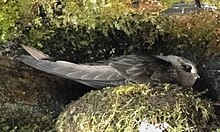American Black Swift
| American Black Swift | |
|---|---|
 | |
| Adult Black Swift on the nest in Shoshone County, Idaho | |
| Conservation status | |
| Scientific classification | |
| Kingdom: | Animalia |
| Phylum: | Chordata |
| Class: | Aves |
| Order: | Apodiformes |
| Family: | Apodidae |
| Genus: | Cypseloides |
| Species: | C. niger |
| Binomial name | |
| Cypseloides niger (Gmelin, 1789) | |
The American Black Swift or more simply Black Swift (Cypseloides niger) is found from northern British Columbia in Canada through the United States and Mexico to Costa Rica and Brazil. It is also found on islands in the West Indies.
In flight, this bird looks like a flying cigar with long slender curved wings. The plumage is mostly a sooty dark gray. There is some contrast between the upper and lower wing. The shoulders are much darker in color than the remaining portion of the wing. They also have short slightly forked tails.
Their breeding habitat is frequently associated with water. The birds most often nest on high cliff faces, either above the ocean surf or behind or next to waterfalls. The nest is made of twigs and moss glued together with mud. They will also use ferns and seaweed if available. The females usually lay 1 egg, sometimes 2, and incubation lasts 23-27 days. Young are fed usually once a day by both parents, most often at dusk.
These birds do migrate out of North America after the breeding season. It remains unclear where most of the birds spend the winter, although some of the birds have been tracked as far south as Brazil, migrating there from Colorado. Some of the birds in the West Indies appear to be permanent residents. They are one of the last migrants to appear, often seen migrating in mid-June to early July. They also migrate in large flocks.
American Black Swifts live on the wing, foraging in flight. They eat flying insects, primarily flying ants and beetles. They usually feed in groups, flying closely together.
Status and distribution
North America
Fewer than 100 Black Swift breeding sites are known in the United States.These include:
- In Alberta: Johnston Canyon.
- In California: the Santa Cruz coast (where it is declining, Berry Creek Falls, Yosemite, Sequoia & Kings Canyon National Parks, San Bernardino Mountains, and the San Jacinto Mountains.
- In Colorado: Box Canyon near Ouray, Hanging Lake, Hawk Creek Falls, Falls Creek Falls and Niagara and Cataract Gulches.
- In New Mexico: Jemez Falls.
- In Utah: Stewart Falls.
- In Washington: Semiahoo Bay

No comments:
Post a Comment